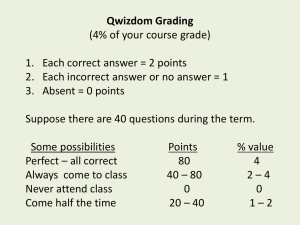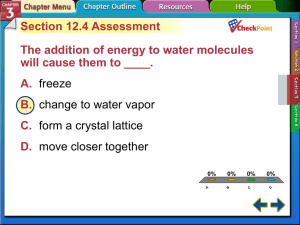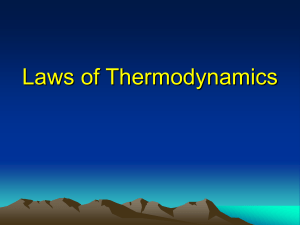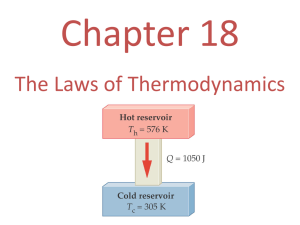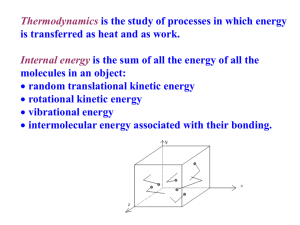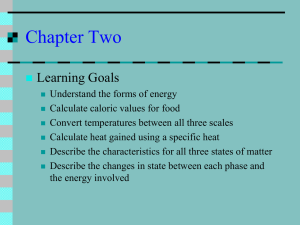Heat and Thermodynamics
advertisement
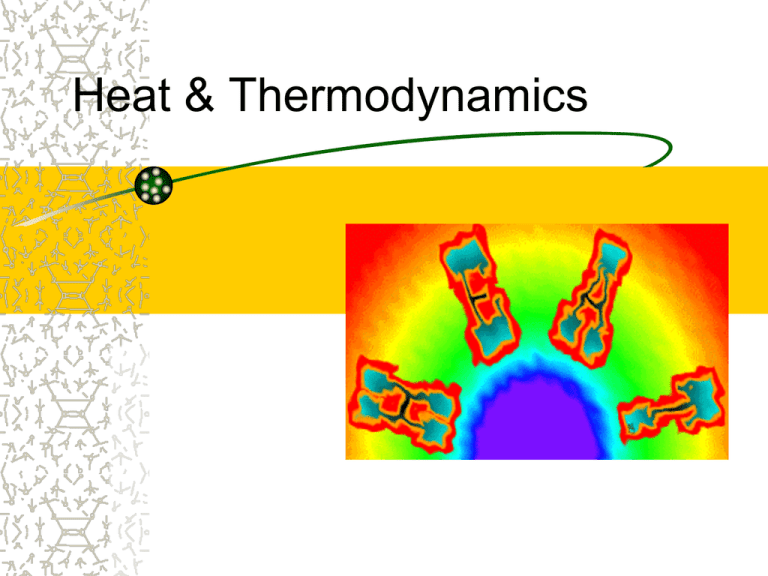
Heat & Thermodynamics What is the Difference Between Heat and Temperature? Both are related to energy but there’s a big difference Temperature Measure of speed of particles (kinetic energy) Measured by thermometers Work by expansion of a liquid Other types use bimetallic strip Digital Thermometers Use “thermistors” - temperature dependant semiconductor resistors Temperature Scales Fahrenheit T(0F) = (1.8x 0C) + 32 Celsius (centigrade) T(0C ) = [T(0F) –32]/1.8 Kelvin (Celsius + 273) Examples Zero degrees Celsius is what Kelvin? Answer: 273o What is the boiling point of water in degrees Kelvin? Answer: 373o 200 degrees Celsius is what in Kelvin? Answer: 473o Absolute Zero 0 degrees Kelvin = -273 Celsius Lowest possible temperature Molecular motion ceases Courtesy Michigan State University Kinetic Theory of Heat All matter is made of tiny atoms and molecules, constantly in motion Faster is hotter solid gas Temperature and Kinetic Energy In ideal gas temperature is proportional to average kinetic energy per molecule Closely related in liquids and gases Temperature does not depend on the amount Heat does depend on the amount There is twice as much kinetic energy of moving molecules in two liters of water as in one liter. Analogy: Heat is like the total height of students in this room, temperature is like their average height. Which has more heat? A swimming pool full of ice water? A cup full of boiling water? Answer: the swimming pool, because it has so much more water. Heat – Energy Transferred Definition: Energy that transfers because of temperature difference Heat flows governed by average molecular kinetic energy difference Heat always flows from high energy to low Cold- Absence of Heat * does not exist! Thermal Equilibrium Objects at same temperature are at thermal equilibrium – no heat flows. Measuring Heat One calorie is the amount of heat needed to raise the temperature of one gram of water by one degree Celsius. Kilocalorie raises the temperature of one kg of water by 10 C (also called Calorie or food calorie) One calorie = 4.186 joules One kilocalorie = 4186 joules One kilocalorie= 1 Food Calorie Density of Water Density is mass per unit volume D = M/V One gram per cubic centimeter One kilogram per liter One thousand kg per cubic meter Specific Heat Capacity Different materials change their temperature by different amounts when they absorb the same amount of heat. Some have more ways of storing energy than others Water has very high specific heat (capacity) Metals have much less Q = mcDT Q = mcDT expresses how heat absorption works. C is specific heat Question: A certain rock has a specific heat of 0.25 (water is 1.0) How much heat will be required to heat 5.0 kg rock from 20 to 800C? Q = 5.0kg x 1000g/kg x 0.25 Cal/g 0C x 60 0C Q = 75,000 C = 7.5 x 104 Calories Calories 1 calorie raises the temperature of 1 gram of water by 1 Celsius degree. 1 kilocalorie (kcal or Calorie) raises temperature of 1 kg of water by 1 degree Celsius 1 British Thermal Unit (BTU) raises temperature of 1 pound of water by one degree Fahrenheit Application If 10 calories of heat go into a gram of water, how much will the temperature increase? Answer : 10 degrees C How much heat is needed to raise the temperature of 10 grams of water by one degree C? Answer: 10 calories How much heat is needed to raise the temperature of 10 grams of water by 10 degrees C? Answer: 100 calories Specific Heat How much does temperature rise when heat is put into something? It depends on the material as well as the mass and the quantity of heat: Q = m c Dt c is specific heat in calories/g oC Water has the highest specific heat of any common material, 1 cal/g oC Metals generally have low specific heats, which makes them easy to cool or heat. Temperature Change Exothermic Reactions, are where heat is released, this will cause the temperature of the surrounding to increase. (think a roaring fire to warm a cold room) ∆T = Tf-Ti Endothermic Reactions, are where heat is absorbed, this will cause the temperature of the surroundings to decrease. (think ice melting in warm drink) ∆T = Ti-Tf Example How much heat is required to raise the temperature of 1000g water from room temperature (20oC) to boiling (100oC)? Q = m c Dt = 1000g x 1 cal/g oC x 80 oC = 80,000 calories (or 80 kilocalories) Fact: It would take about a tenth as much heat to raise the temperature of an equal amount of iron this much Other Examples If 2000 J of energy are added to .25 kg of water at an initial temperature of 35⁰C what will the final temperature be? If 5000 cal are added to an unknown substance and 200 g of it change temperature by 34⁰C what is the specific heat of that substance? Mixtures 100 g of water at 50oC is added to 100g water at 70oC. What will be the final temperature? You guessed it: 60oC Mix a liter of 20oC water with two liters of 30oC water. What is the final temperature of the system? Calorimeter Energy device used to eliminate the loss of energy to the surroundings. Thermos and styrofoam cup work on same principles. High Specific Heat of Water Makes it a good coolant (water also has high conductivity although this is not the same) Large bodies of water such as oceans moderate climate – Gives coastal communities relatively mild summers and winters Another peculiar fact about water. It’s highest density (and smallest volume) is at 4oC. – Water at bottom of frozen lake is always 4oC Change of Phase Heat of Fusion Energy needed to melt 1 gram of a solid into its liquid form. Hf ice= 80 cal/g Hf= Q/m Q= Hf x m m= Q/Hf This is endothermic, absorbed into the system, the same is true of the releasing, just called Heat of Crystallization. Heat of Vaporization Energy needed to vaporize 1 g of some liquid into a gas. Hv water= 540 cal/g Hv= Q/m Q= Hv x m m = Q/Hv This is endothermic as well, again being absorbed, the same is true of releasing just called Heat of Condensation. Phase Change Example How many calories are required to raise the temperature of 85 grams of – 20⁰C ice to 150⁰C? (Think about all the different steps you must take to solve this problem) ∆T of ice Phase change (melt the ice) ∆T of water Phase change (boil the water) ∆T of steam Heat of Fusion Lab (Prove Hf= 80 cal/g) Cook 125 ml of water to exactly 50⁰C. Record Ti. Pour exactly 100 ml of water into sty. cup. Record Vi. (DO NOT DESTROY STY. CUPS) Add ice chips 2-3 at a time, carefully stirring with thermometer, until you reach 0⁰C. Record Tf. Carefully remove any ice chips. Record Vf. Remember Dwater 1g= 1 ml Calculate Q (released by water)= m x ∆T x c Calculate the mass of melted ice= Vf-Vi Calculate the Hf of ice = Q/m Answer this question: Why did we start at 50⁰C? Hint: Think about heat exchange and room temperature. Thermal Expansion Most materials expand when heated Only exception is water between 00C and 400C Expansion joints in bridges, cracks in sidewalks allow for expansion Bimetallic Strip How your thermostat works Don’t Let Your Car’s Engine Overheat Aluminum expands more than iron Pistons made of aluminum Cylinder made of iron Mechanical Equivalent of Heat Discovered by James Joule Falling weight makes paddle turn 4.186 x 103 J = 1 kcal Interpretation: HEAT IS ENERGY TRANSFER Courtesy W. Bauer http://lecture.lite.msu.edu/~mmp/kap 11/cd295.htm Joule’s Apparatus Link to Joule’s original article Example When digested a slice of bread yields 100 kcal. How high a hill would a 60 kg student need to climb to “work off” this slice of bread? 100 kcal x 4.186 x 103 J/kcal = 4.2 x 105 J W = mgh h = W/mg = 4.2 x 105 / (60 kg)(9.80 m/s2) = 714m = 7.1 x 102 m If the body is only 20 percent efficient in transforming the bread, how high need they climb? Bullet in Block When a 10 g bullet traveling 500 m/s is stopped inside a 1kg wood block nearly all its KE is transformed to heat. How many kcal are released? KE = ½ mv2 = 0.5 x 0.010 kg x (500)2 = 1250 J 1250 J x 1 kcal/4186 J = 0.30 kcal Thermodynamics Study of heat and its transformation into mechanical energy Based on conservation of energy Explains how engines like car motors work First Law of Thermodynamics Generally, when you add heat to a system it changes into an equal amount of some other form of energy Heat added = increase in internal energy + external work done by the system Work Done On and By Compressing a gas by pushing down on a piston = work done on A gas expands by pushing a piston up = work done by Questions 20 J of heat is added to a system that does no work. What is the change in internal energy? Answer +20 J 20 J of heat is added to a system that does 10 J of work. What is the change in internal energy? Answer +10 J 20 J of heat is added to a system that does 30 J of work. What is the change of internal energy? Answer -10 J 20 J of heat is added to a system that has 10 J of work done on it. What is the change of internal energy? Answer +30 J Bicycle Pump What do you think happens when you operate the pump. Where does the work you do go? It goes to heat, some through friction, some to adiabatic compression of the air inside the pump What does “adiabatic” mean? Answer: No heat enters or leaves Q=0 Adiabatic Processes Compression or expansion of a gas so that no heat enters or leaves Example: gas in cylinder of car or diesel engine Why adiabatic? Because it happens too fast for much heat to enter or leave. In adiabatic compression, temperature rises. – In diesel engine, enough to ignite gas without spark plug A process can also be adiabatic if it happens inside a well insulated conatiner. Courtesy “How Stuff Works” Courtesy Shell Canada Adiabatic Expansion Produces cooling Example: blow on your hand first with wide open mouth, then with puckered lips How do you explain the results? The Chinook What would you expect to happen if cold air moves down the slopes of mountains Hint: it will be compressed by atmosphere into smaller volume Chinook wind is warm Common in Rocky mountains Second Law of Thermodynamics Heat flows from hot to cold. By itself it will never flow from cold to hot. Question: Would it violate the First Law of Thermodynamics (energy conservation) if heat flowed from a cold object to a warm object touching it? Answer: No Second Law Applied to Engines It is impossible to build a heat engine that changes heat completely into work. Such an engine would be 100% efficient! Allowed by 1st law, forbidden by 2nd law Courtesy University of Oregon Heat Engine Some heat is converted to useful work The rest is exhausted on at a lower temperature (cause of thermal pollution) Efficiency = useful work / heat input – About 20-25% for gasoline engine – About 35-40% for diesel engine The energy exhausted is waste, cannot be recovered Ideal (Carnot) Engine Ideal (Maximum possible efficiency) = (Thot – Tcold)/Thot (Kelvin temperatures) What is the efficiency of a steam turbine (assumed ideal) operating between 400K (1270C) and 300K (270C)? (400 – 300)/400 = ¼ or 25% What would be the efficiency if the turbine could 1/2 operate at 600K? What would the exhaust temperature need to be for an engine to be 100% efficient? 0K Steam Turbine Limits to Technology What factors limit the efficiency of an engine? – Friction – Temperature at which parts melt – Carnot efficiency What would be the advantages of a ceramic engine? Disadvantages? Can operate at 3000 degrees without cooling, is light and doesn’t need much cooling, but… Courtesy University of Colorado Heat Engine Summary Work done is difference between heat flow in at high temperature and the heat flow out at a lower temperature (conservation of energy) Order and Disorder Useful energy tends to degenerate and become less useful Alternate statement of 2nd Law: Natural systems tend toward disorder Question: Could all the air molecules in this room spontaneously concentrate at the top of the room (more orderly system)? Entropy A measure of how much change occurs when energy spreads out according to the second law. More generally (and less accurately) a measure of disorder When disorder increases, entropy increases Mess to Neat? Will this mess become neat all by itself? No way! Will this dish reassemble all by itself? No Way, the Second Law of Thermodynamics prohibits it Entropy Summary Entropy is a quantity that measures the order or disorder of a system This quantity is larger for a more disordered system The Second Law of Thermodynamics says that entropy tends to increase All real engines lose heat to their surroundings Courtesy California Science Standards in Physics Global Warming Courtesy University of Oregon Calorimetry and Specific Heat Heat and Temperature Basics Temperature does not depend on the amount If two samples of identical material are at the same temperature, the sample with more mass has more thermal energy (internal energy) Heat is thermal energy transferred Internal energy is thermal energy in something Which Contains More Thermal Energy? A cup of boiling water or a swimming pool frozen solid? Answer: the swimming pool. What it loses in temperature it more than makes up in mass This will become clearer as we learn more… Hot Stuff What would happen if 1 kg iron (specific heat 0.11 calories/ g oC) at 300 oC were placed in 200g water at 20 oC? Heat lost by iron = heat gained by water Let TW be initial temp. of water; TI that of iron; TF final temp of both mIcI(TI-TF) = mW cW (TF – TW) mIcI TI – mIcITF = mW cW TF - mW cW TW
